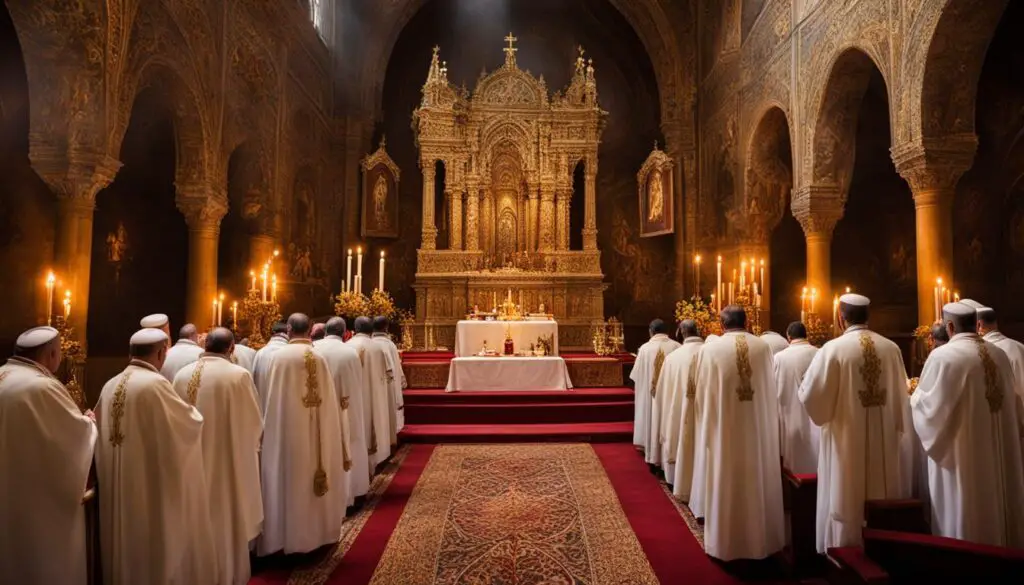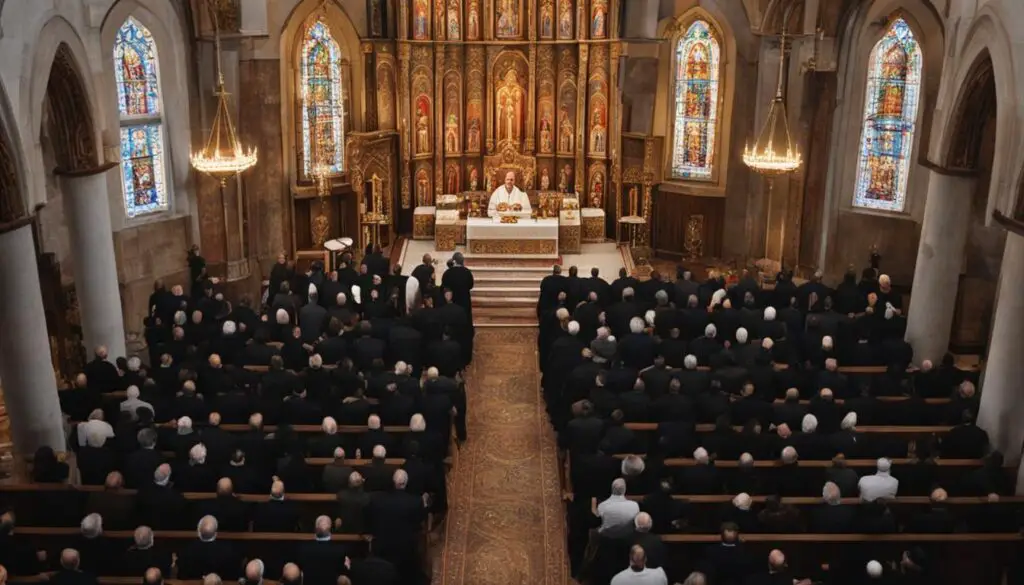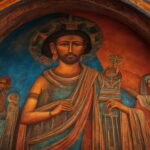The Armenian Apostolic Church, also known as the Armenian Orthodox Church or Armenian Gregorian Church, has a rich history that dates back to the 1st century. It is the national church of Armenia and holds a significant place in the country’s cultural and religious identity.
The origins of the Armenian Apostolic Church can be traced back to the Apostles Bartholomew and Thaddeus of Edessa, who are believed to have brought Christianity to Armenia. However, it was St. Gregory the Illuminator who played a pivotal role in the Christianization of Armenia in the early 4th century. He became the first official primate of the church, establishing a solid foundation for Armenian Christianity.
The Armenian Apostolic Church has withstood centuries of challenges and adversities, preserving its ancient traditions and customs. Today, it continues to be an influential institution, shaping the spiritual and cultural landscape of Armenia and its diaspora.
Key Takeaways:
- The Armenian Apostolic Church traces its origins back to the 1st century and is the national church of Armenia.
- St. Gregory the Illuminator played a crucial role in the Christianization of Armenia and became the first official primate of the church.
- The Armenian Apostolic Church has preserved its ancient traditions and continues to be a significant institution in Armenian society.
- It holds a strong cultural and religious identity, shaping the spiritual and cultural landscape of Armenia and its diaspora.
- The church has endured challenges over the centuries, remaining resilient in the face of adversities.
Beliefs and Doctrines
The Armenian Apostolic Church is rooted in a distinct theological tradition known as miaphysitism. This belief asserts that Jesus Christ, the Son of God, possesses a single nature that is both fully divine and fully human. Unlike other Christian denominations, the Armenian Apostolic Church rejects the notion of two separate natures in Christ as defined by the Council of Chalcedon in 451 AD. Instead, it upholds the unity of Christ’s nature, emphasizing the inseparable union of His divinity and humanity.
Central to the faith of the Armenian Apostolic Church are the sacraments, considered sacred rituals that convey the grace of God to the believers. Two sacraments, namely, baptism and the Eucharist, hold particular significance.
Baptism is viewed as the gateway to spiritual rebirth and membership in the Church. Through baptism, individuals are cleansed of original sin and initiated into the Christian community. The sacrament is typically performed through immersion or pouring of water on the head, following the example set by Jesus’ own baptism in the Jordan River.
The Eucharist, also known as the Divine Liturgy, is the central act of worship in the Armenian Apostolic Church. During the Eucharistic celebration, the bread and wine (which symbolize the body and blood of Christ) are consecrated and consumed by the faithful, signifying their participation in the sacrificial offering of Christ and uniting them with His divine presence.
Along with these sacraments, the Armenian Apostolic Church adheres to the moral teachings of Christianity, which include the Ten Commandments and teachings on love, humility, and compassion. The church places a strong emphasis on the sanctity of life and family values, promoting principles that foster healthy relationships, respect for all human beings, and the preservation of society’s moral fabric.
Overall, the beliefs and doctrines of the Armenian Apostolic Church reflect its commitment to the unique theological perspective of miaphysitism and its dedication to upholding the teachings and traditions of Armenian Christianity.
Sacraments and Rituals
The Armenian Apostolic Church embraces a rich tradition of sacraments and rituals that hold deep spiritual significance for its members. These practices are an integral part of the church’s worship and communal life, providing a means for believers to connect with God and receive His grace.
Baptism
Baptism, performed through immersion, is the sacrament of initiation into the Armenian Apostolic Church. It symbolizes the cleansing of sins and the entrance into the Christian faith. Through baptism, individuals are welcomed into the church community and become partakers of God’s divine love and mercy.
The Holy Eucharist
The Holy Eucharist, also known as the Divine Liturgy, is the central act of worship in the Armenian Apostolic Church. This sacrament commemorates the Last Supper, where Jesus Christ instituted the ritual of sharing bread and wine as His body and blood. During the Divine Liturgy, the bread and wine are consecrated and believed to become the true presence of Christ, offering spiritual nourishment and unity with God.
Confirmation, Penance, Holy Orders, Matrimony, and Unction of the Sick
In addition to baptism and the Holy Eucharist, the Armenian Apostolic Church recognizes five other sacraments:
- Confirmation: In this sacrament, individuals receive the gift of the Holy Spirit, strengthening their faith and commitment to living a Christian life.
- Penance: Also known as confession, this sacrament allows believers to repent and seek forgiveness for their sins, receiving absolution from a priest.
- Holy Orders: Through this sacrament, men are ordained as deacons, priests, or bishops, assuming specific roles within the church hierarchy.
- Matrimony: The sacrament of marriage unites a man and a woman in a lifelong commitment, blessed by the church and God.
- Unction of the Sick: In this sacrament, the sick and suffering are anointed with holy oil and offered prayers for physical and spiritual healing.
Rituals and Traditions
Alongside the sacraments, the Armenian Apostolic Church preserves various rituals and traditions that reflect its rich cultural heritage and religious beliefs. These rituals include:
- The blessing of grapes on the Feast of the Assumption, symbolizing the abundance and blessings of God;
- The lighting of candles during religious services, representing the light of Christ;
- The use of incense to signify the prayers of the faithful rising to heaven;
- The veneration of saints and icons as a way to honor their spiritual contributions;
- The practice of fasting and prayer during specific periods, such as Lent, to purify the soul and deepen spiritual devotion.
The Armenian Apostolic Church’s sacraments and rituals serve as essential expressions of faith, providing believers with opportunities to encounter God’s presence and nurture their spiritual growth.
| Sacraments | Description |
|---|---|
| Baptism | The sacrament of initiation into the church, performed through immersion, symbolizing cleansing of sins and joining the Christian faith. |
| The Holy Eucharist (Divine Liturgy) | The central act of worship, commemorating the Last Supper, where bread and wine are consecrated as the true presence of Christ. |
| Confirmation | Receiving the gift of the Holy Spirit, strengthening faith and commitment to the Christian life. |
| Penance | Confession and seeking forgiveness for sins, receiving absolution from a priest. |
| Holy Orders | Ordination of men as deacons, priests, or bishops, assuming specific roles within the church hierarchy. |
| Matrimony | Uniting a man and a woman in marriage, blessed by the church and God. |
| Unction of the Sick | Anointing the sick with holy oil and offering prayers for physical and spiritual healing. |

Leadership and Clergy
In the Armenian Apostolic Church, the spiritual guidance and administration of sacraments are entrusted to a hierarchy of clergy. At the helm of the church stands the Catholicos of All Armenians, currently Karekin II, who holds the highest ecclesiastical authority. As the spiritual leader of the church, the Catholicos plays a vital role in shaping the religious and cultural identity of the Armenian Apostolic Church.
Bishops and priests fulfill essential roles within the church community. Bishops oversee multiple parishes and serve as the shepherds of their respective regions. Their responsibilities include ordaining priests, managing church affairs, and providing pastoral care. Priests, on the other hand, play a direct role in the spiritual guidance of the Armenian church community. They lead worship services, administer sacraments, and offer guidance and support to individuals seeking spiritual solace.
The clergy’s dedication and commitment are of paramount importance in fostering a vibrant Armenian church community. Their leadership inspires individuals to deepen their faith and actively participate in the sacramental life of the church. Through their guidance, the clergy plays a crucial role in preserving and perpetuating the rich traditions and values of the Armenian Apostolic Church.
The Role of Archimandrites
Among the clergy, Archimandrites hold a special place in the Armenian Apostolic Church. These revered individuals are distinguished for their deep theological knowledge and spiritual insight. Archimandrites often serve as abbots of monastic communities, guiding monks and nuns in their spiritual journeys. They embody the ascetic ideals of the church, leading lives of prayer, contemplation, and self-denial.
“The clergy’s dedication and commitment are of paramount importance in fostering a vibrant Armenian church community.”

| Position | Description |
|---|---|
| Catholicos of All Armenians | The spiritual leader and highest ecclesiastical authority of the Armenian Apostolic Church. |
| Bishops | Oversee multiple parishes, ordain priests, and provide pastoral care. |
| Priests | Lead worship services, administer sacraments, and offer spiritual guidance. |
| Archimandrites | Distinguished individuals with deep theological knowledge and spiritual insight, often serving as abbots of monastic communities. |
Worship Practices
Worship in the Armenian Apostolic Church is a deeply meaningful and reverent experience. It is characterized by rich liturgical traditions and rituals that have been passed down through generations. The centerpiece of worship is the Divine Liturgy, a solemn and sacred service performed in classical Armenian.
The Divine Liturgy is a profound act of communion with God and the community. It involves prayers, hymns, scripture readings, and the consecration of the bread and wine, symbolizing the body and blood of Christ. This sacramental act is deeply cherished by the faithful, who believe in its transformative power.
The Armenian Apostolic Church follows a liturgical year that encompasses various feasts and fasts. This includes significant events such as Christmas, Easter, and the Great Lent. These seasons provide opportunities for the faithful to engage in spiritual reflection, repentance, and renewal.
“Worship in the Armenian Apostolic Church is a spiritual journey, a time of deep connection with God and the community.” – Archbishop Hovnan Derderian
During worship services, the use of icons, incense, and liturgical chants adds to the solemnity and beauty of the experience. Icons, sacred images of Christ, the Virgin Mary, and saints, are venerated as windows into the divine presence. The aroma of incense symbolizes the prayers of the faithful rising to heaven, creating a sacred atmosphere. Liturgical chants, often sung by choirs or priests, fill the space with melodic hymns that uplift the soul and inspire devotion.
The elements of worship in the Armenian Apostolic Church not only nourish the spiritual lives of the faithful but also serve as a visual and auditory feast for the senses, creating a truly immersive and awe-inspiring worship experience.

Schedule of Liturgical Services
Here is a glimpse of the typical schedule of liturgical services in the Armenian Apostolic Church:
| Day of the Week | Service | Approximate Time |
|---|---|---|
| Sunday | Divine Liturgy | 10:00 AM |
| Thursday | Vesper Service | 6:00 PM |
| Saturday | Holy Communion | 9:00 AM |
Please note that the schedule may vary depending on the specific church and local customs. It is always best to check with your local Armenian Apostolic Church for the most accurate information.
Sacred Texts
The Armenian Apostolic Church holds the Bible as its sacred text, upholding its significance in the spiritual life of its followers. Of particular importance is the Armenian Bible, translated by St. Mesrob Mashtots in the 5th century. This translation holds a special place in Armenian culture and literature, serving as one of the earliest translations of the Bible.
St. Mesrob Mashtots’ translation of the Bible into Armenian played a vital role in the preservation and promotion of the Armenian language, as well as the dissemination of Christian teachings throughout the region. It solidified the foundation of Armenian Christianity and became an integral part of the nation’s identity.
In addition to the Bible, the Armenian Apostolic Church also reveres the writings of early Church Fathers. Among them are St. Gregory of Nazianzus and St. John Chrysostom, whose works have been translated into Armenian and provide valuable insights and guidance for believers.

Translations of the Bible
| Translation | Language | Year |
|---|---|---|
| Armenian Bible | Armenian | 5th century |
| King James Version | English | 1611 |
| Vulgate | Latin | 4th century |
| Biblia Hebraica Stuttgartensia | Hebrew | 1977 |
| Septuagint | Ancient Greek | 3rd century BCE |
Denominations and Sects
The Armenian Apostolic Church is the primary denomination within Armenian Christianity. However, it is important to note that there are other Armenian Christian denominations and sects that exist alongside it, each with its own distinct beliefs and practices.
One notable example is the Armenian Catholic Church, which follows the Armenian Catholic Rite and is in communion with the Holy See in Rome. This branch of the Armenian Christian community combines elements of the Armenian Apostolic Church with the teachings and authority of the Roman Catholic Church.
Additionally, there are smaller independent Armenian Christian churches that have emerged over time. These churches may have variations in their doctrines and practices, but they are not as numerous as the Armenian Apostolic Church, which remains the dominant religious institution within the Armenian community.
While each of these denominations and sects may have their unique identities, they all share a common heritage rooted in Armenian Christianity and contribute to the diverse religious landscape of the Armenian people.
Differences in Doctrine and Practice
Although the Armenian Apostolic Church and its various denominational counterparts share a common foundation in Armenian Christianity, there are differences in their beliefs and practices.
For example, the Armenian Apostolic Church adopts the theology of miaphysitism, which maintains that Christ has one nature that is both divine and human. This belief differs from the Orthodox Chalcedonian definition, which posits two distinct natures in Christ. These theological variances have led to separate denominations within Armenian Christianity.
Despite these differences, there is often a spirit of mutual respect and cooperation among the various Armenian Christian denominations, as they recognize their shared religious heritage and strive to foster unity within the Armenian community.
Comparison of Denominations
| Denomination | Beliefs | Leadership |
|---|---|---|
| Armenian Apostolic Church | Miaphysitism, one nature of Christ Strong emphasis on sacraments Traditional moral teachings |
Catholicos of All Armenians |
| Armenian Catholic Church | Combination of Armenian Apostolic Church and Roman Catholic Church Rite and practices aligned with Catholicism |
Archbishop or Patriarch |
| Independent Armenian Christian Churches | Varying doctrines and practices Not as numerous as Armenian Apostolic Church |
Varies |
As the table illustrates, the Armenian Apostolic Church is led by the Catholicos of All Armenians, while the Armenian Catholic Church is led by an Archbishop or Patriarch. The independent Armenian Christian churches may have different forms of leadership depending on their specific denomination.
Community and Outreach
The Armenian Apostolic Church is deeply committed to fostering a strong sense of community and actively engaging in outreach efforts to support the Armenian Church community and promote its values. Through various charitable works and initiatives, the church strives to make a positive impact on the lives of individuals and families.
One of the primary ways the Armenian Apostolic Church demonstrates its commitment to community is through charitable endeavors. The church extends a helping hand to the less fortunate by providing aid to the poor, offering support to orphanages, and contributing to the establishment and maintenance of schools. These efforts aim to uplift and empower individuals, ensuring they have access to essential resources and education.
To strengthen the bonds within the Armenian Church community, the church organizes a wide array of community events. These events serve as opportunities for individuals to come together, celebrate their heritage, and connect with one another. Cultural festivals showcase the vibrant traditions and customs of Armenian culture, while pilgrimages provide a profound spiritual experience. Additionally, religious processions offer a visible expression of faith and unity within the community.
“The strength of the Armenian Apostolic Church lies in the close-knit community it fosters and the connections between its members. By organizing numerous events and initiatives, the church ensures that Armenians can come together to celebrate their culture and faith, forging lifelong connections along the way.”
Furthermore, the Armenian Apostolic Church plays a significant role in the preservation and promotion of Armenian culture, language, and heritage. The church encourages the use and teaching of the Armenian language, holding it as an integral part of Armenian identity. It actively supports initiatives that preserve historical landmarks, such as monasteries and churches, showcasing the rich architectural and artistic features of Armenian Christianity.
Through its community and outreach efforts, the Armenian Apostolic Church stands as a pillar of support for the Armenian Church community. By nurturing a strong sense of community, embracing cultural traditions, and engaging in charitable works, the church serves as a beacon of hope and unity for Armenians around the world.
Contemporary Issues and Challenges
The Armenian Apostolic Church, like other Christian denominations, faces various contemporary issues and challenges. One of the significant challenges is addressing the needs of the modern Armenian diaspora. As Armenians have migrated to different parts of the world, the church strives to provide spiritual support and maintain connections with the diaspora community, while also adapting to the unique needs and cultural contexts of its members.
Adapting to social and cultural changes is another important aspect for the Armenian Apostolic Church. In a rapidly changing world, where society’s values and norms are evolving, the church seeks to offer guidance and support to its faithful, while staying true to its core beliefs and traditions. It constantly examines how to effectively engage with contemporary issues, such as gender roles, technological advancements, and changing family structures.
Engaging in ecumenical dialogues with other Christian traditions is an ongoing priority for the Armenian Apostolic Church. It seeks to foster interfaith understanding and cooperation, participating in discussions and collaborations with various Christian denominations. These dialogues aim to promote unity and explore shared values and beliefs, bridging the gaps between different religious traditions.
Amidst the complexities of political and social dynamics in Armenia and the broader region, the Armenian Apostolic Church continues to play a central role. It strives to maintain its independence while navigating the challenges of a rapidly changing world. The church’s enduring presence and active engagement in spiritual and cultural matters make it an essential pillar of Armenian society, preserving the rich religious traditions and heritage of Armenians.
FAQ
What is the history of the Armenian Apostolic Church?
The Armenian Apostolic Church traces its origins back to the 1st century and is the national church of Armenia. It became the official religion of Armenia in the early 4th century.
What are the beliefs and doctrines of the Armenian Apostolic Church?
The Armenian Apostolic Church embraces miaphysitism, believes in the unity of Christ’s divine and human nature, and upholds traditional Christian moral teachings.
What are the sacraments and rituals of the Armenian Apostolic Church?
The Armenian Apostolic Church recognizes seven sacraments, including baptism, Holy Eucharist, and matrimony, and observes various rituals and traditions, such as the blessing of grapes.
Who are the leaders and clergy of the Armenian Apostolic Church?
The Armenian Apostolic Church is headed by the Catholicos of All Armenians, who is the highest ecclesiastical authority. The clergy play a vital role in providing spiritual guidance and administering sacraments.
What are the worship practices of the Armenian Apostolic Church?
Worship in the Armenian Apostolic Church is characterized by rich liturgical traditions and rituals, including the Divine Liturgy, prayers, hymns, and the use of icons and incense.
What are the sacred texts of the Armenian Apostolic Church?
The Armenian Apostolic Church considers the Bible as its sacred text, with the Armenian Bible being one of the earliest translations. The church also values the writings of early Church Fathers.
Are there other denominations and sects within Armenian Christianity?
Yes, there are other Armenian Christian denominations and sects, such as the Armenian Catholic Church, which follows the Armenian Catholic Rite and is in communion with the Holy See in Rome.
How does the Armenian Apostolic Church engage with the community?
The Armenian Apostolic Church actively engages in charitable works, organizes community events, and plays a significant role in the preservation and promotion of Armenian culture and heritage.
What are some contemporary issues and challenges faced by the Armenian Apostolic Church?
The Armenian Apostolic Church faces various challenges, such as addressing the needs of the modern Armenian diaspora and navigating social and cultural changes, as well as engaging in ecumenical dialogues with other Christian traditions.
















